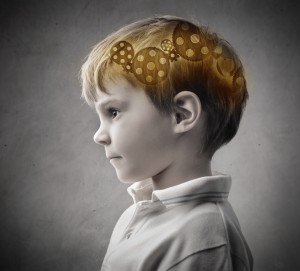 Brain Development in Children
Brain Development in Children
Your child is pitching a fit right in the middle of the grocery store, or refusing to see the rationale in going to bed. In either scenario you might be wondering, what’s really going on inside his or her head right now?
Thanks to modern neuroscience, little kids aren’t all the mystery they are cracked up to be. As knowledge advances, we are learning more and more about the human brain and how it grows, develops, and reacts to its environment. Here we break down how your child’s brain is developing, and the cognitive skills that come with age.
Stages Of Brain Development: Birth To Toddler
One week after conception, the brain already begins to develop. The wrinkled appearance of the brain develops during the prenatal stage as a way to allow room for more information to be packed inside. By birth, your child has 100 billion brain cells that travel and connect with one another. A newborn doesn’t understand punishment or praise; they spit up, go to the bathroom in their diaper, and cry uncontrollably. All of these emotional and reactive behaviors reflect that the majority of baby brain usage only comes from the lower chambers.
In the first few months of your child’s life many changes are taking place, they are learning how to smile, hold up their head, respond to certain stimuli. But even when your child starts to talk and walk, their brain is continuing to grow at a rapid rate.
By 24-36 months your child’s brain is growing to incorporate movement, language, cognition learning, and social emotional concepts.
This is the perfect time to enroll your child in preschool because the more knowledge and experiences they have a chance to soak up at this age, the better their brain will develop. All areas of development are interconnected and equally important at this stage, which is why preschool curriculum focusing on physical, social, cognitive, learning, and emotional tasks can enhance a child’s future educational career.
At a young age your child’s brain is busy growing, learning, and making new connections for the first time. Between the ages of birth to 4 years, the brain develops 80% of its weight. The cause of the brain growing has to do with the myelination. This process continues long past childhood into early adulthood as well, especially in relation to the prefrontal cortex of the brain (More Information).
Refresher Course: Parts of the Brain
To understand how your child’s brain is developing, here’s a quick review on the basic parts of the human brain.
The brain stem is what connects the brain to the spinal cord, controlling everything from breathing to heart rate without any conscious thoughts.
The cerebellum helps control your ability to balance, throw a ball, and use coordination.
The cerebrum is the largest part of the brain, attached just above the brain stem and cerebellum. This part of the brain is closely linked with memory and higher processing, such as planning and decision-making. The cerebrum is under 1/4th of an inch thick in adulthood, and even thinner in childhood.
You and your child both have all of these working parts, but in order for your child to learn all that you do, it’s the synapses and neurons that have to learn how to work together. As these connections are made, your child is slowly developing into a functioning and independent individual, capable of grouping and sorting things into categories so that they can process and react to the world around them.
Synapses And Pruning: The Inner Workings Of The Brain
Synapse formation is also occurring at an early age, when the brain fires off more synapses than it could ever use. The pruning process is what helps your child’s brain configure which synapse connections are important and which are non-essential. To speed up brainpower, the brain will “prune” away the unnecessary synapse formations. As your child’s brain grows so will their ability to communicate and understand the world around them. Language is a great example of this; the more your child hears a language, the faster they make connections with certain words and sounds, eventually learning the language completely.
By the time your child is 2 ½ they will know around 300 words—on average. Your child’s brain grows because it is fed blood and oxygen, but it also grows because of outside stimuli and learning experiences. This is why, the more learning materials your child is exposed to, the more organized their brain becomes, as they are able to recognize and sort a larger amount of data into appropriate categories.
How To Help Foster Healthy Development For Children
The brain is an incredible mechanism that science is still studying to fully understand, but that doesn’t mean we don’t know a lot. Already we understand many amazing attributes of the brain. For instance, looking at brain wave patterns can identify certain traumatic experiences during key developmental periods. Children that undergo the same negative experiences around the same time, have a similar brain wave pattern as indication. Everything that your child sees, hears, and is exposed to impacts what their brain knows, how they react to situations, and so much more.
Your child’s physical development is nurtured by nutrition and physical activity. Learning and playing simultaneously promote your child’s intellectual development. As for emotional development, it’s all about giving and receiving love. A child in a happy home with a good amount of stimuli, attention, learning materials, and love is most likely to develop a big smart brain.
At ABC Learning we provide a high quality daycare and preschool curriculum made especially to foster all types of early brain development.
